#alt-text description instructions included
Text



Come. Join me in my madness.
*caveat: this works best in small sizes—anything big will probably need a more complex stitching setup, end papers, and sturdier book covers. My tiny books have been measuring about 1.5x2.2 cm, and .4 cm thick
#go forth#make some tiny books#i can stop any time I want#but I don’t want to#miniatures#book binding#handlettering#my font#alt-text description instructions included#phew!#if you make one I wanna see it!!#so we can squee together#tried to add alt text to my images!
3K notes
·
View notes
Text
WELCOME TO ROUND 2 OF THE POETRY SMACKDOWN

Hello again. First I just wanna say how excited I am at the response to this bracket. I was going to consider it a smashing success if like forty people voted, so needless to say it has outperformed my expectations, and I’ve really really enjoyed talking with folks and seeing everyone's responses to these poems! That said, 14/16 of my votes were in the minority, so actually fuck you guys. 🩷
Anyways Round 2! Transcriptions are included this time in alt text—sincere apologies to everyone for whom Round 1 was inaccessible, and many thanks to @army-of-bee-assassins and @accessibleaesthetics for being so generous with their helpful advice and feedback. I'm still going back and forth about whether to include just alt text or to include the image descriptions in the body of the post as well, but I've reformatted it in my drafts like twice already so at this point I'm just hitting publish and opening it up for feedback.
I've also included links to readings by the author for all the poems where one was available, for anyone interested in getting a fresh perspective.
enjoy!
-amelia @poetriarchy

ROUND 2: ENDS JULY 26th at 6pm EDT
“The Two-Headed Calf” by Laura Gilpin vs. “Poem” by Langston Hughes
"Miss you. Would like to grab that chilled tofu we love." by Gabrielle Calvocoressi vs. “Hammond B3 Organ Cistern” by Gabrielle Calvocoressi
“someone will remember us” (Fragment 147 from Sappho trans. Anne Carson) vs. “The Quiet World” by Jeffrey McDaniel
“Come. And Be My Baby” by Maya Angelou vs. “Wild Geese” by Mary Oliver
“The Orange” by Wendy Cope vs. “Instructions on Not Giving Up” by Ada Limón
“To The Young Who Want to Die” by Gwendolyn Brooks vs. “Meditations in an Emergency” by Cameron Awkward-Rich
“I’m not a religious person but” by Chen Chen vs. “How to Be a Dog” by Andrew Kane
“I’m Going Back to Minnesota Where Sadness Makes Sense” by Danez Smith vs. “Having ‘Having a Coke With You’ With You” by Mark Leidner
#round2#poetry smackdown#poetry#poll#don't ask why i'm wasting my time on these stupid graphics lol. just know it's not smart of me#masterpost
432 notes
·
View notes
Text
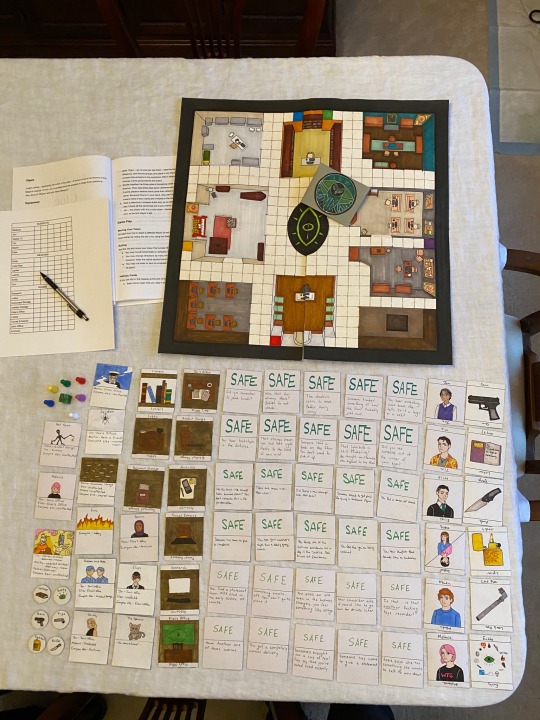
In collaboration with @the-zenith-calls and @tecceran , I present The Magnus Archives themed Clue!! We spent several hours over the course of a couple weeks working on this, and play tested it properly for the first time last night. Check out both of their blogs for details of what they made (when theirs are posted I will link them here and here as well), and below the cut I will be putting details of my contributions :]
(image descriptions in alt text, though I haven't used alt text before so hopefully they do actually work)
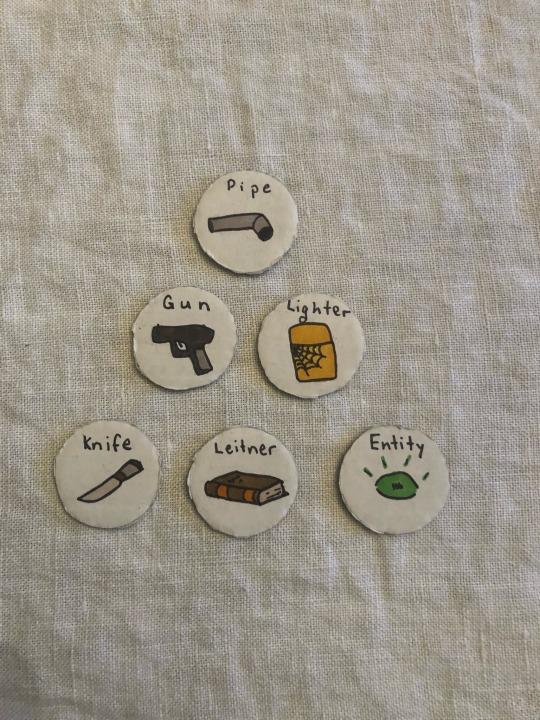
Firstly, the weapons tokens. These were just cut out of cardboard in the style of the tokens that are included in my Star Wars Clue set

I was also responsible for room cards! Of these, Jon’s Office and the Archives are my favorites


We also have varying hallway cards, based on a mechanic in my Star Wars Clue, again.
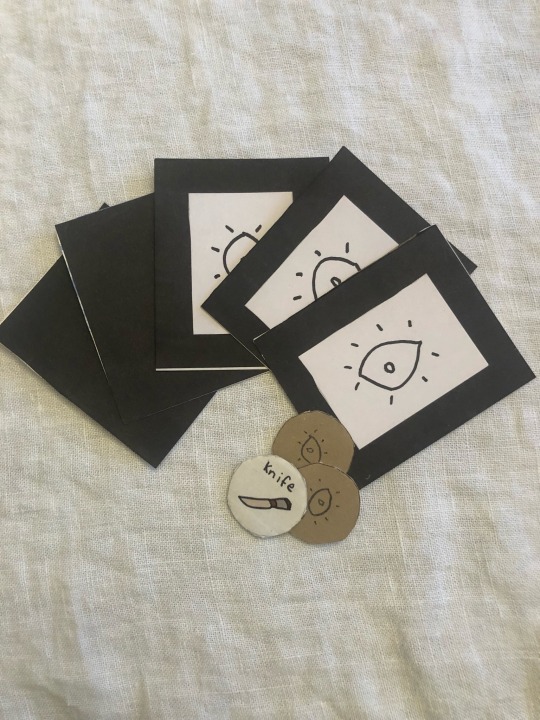
The backs of the cards had to get covered somehow because markers bleed, so the hallway cards are plain black and the other cards have eye designs on them

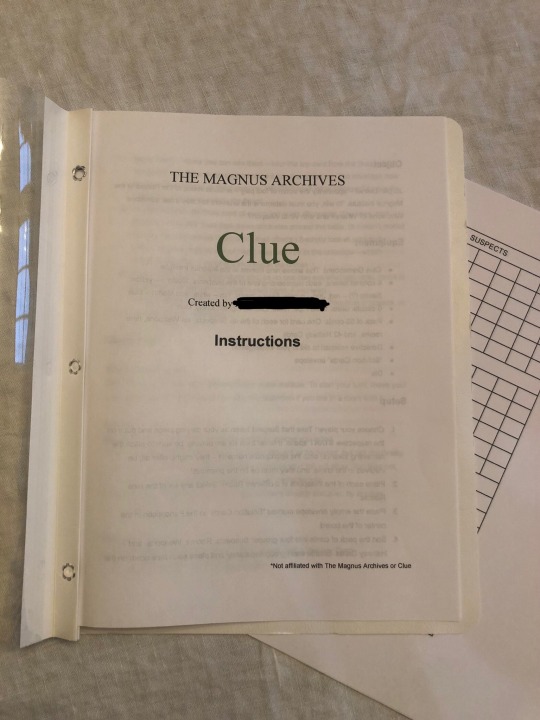
I also formatted and printed out detective note sheets and an Instructions booklet! Details on the instruction booklet will end up in a reblog because I'm running out of images oops. Most of the instructions are just copied word for word from my Clue set instructions, with some alterations made, except for completely made up mechanics, which the-zenith-calls wrote and I reworded if necessary and formatted nicely.
#the magnus archives#tma#i guess i dont really need any other tags#i dont know ive never posted in this fandom before#just finsihed this podcast like a week ago most of this was made when i was existing with like season 3(?) knowledge#that or season 4#yeah so the zenith calls and i just went wild one day in august and made most of the cards and then the day after got tecceran involved#to make michael and then we playtested it by putting sticky notes on the rooms of my actual clue game#definitely go to zenith's post cause they have the board which they MADE BY HAND#GUYS THEY MADE THAT WHOLE CLUE BOARD. BY HAND#yeah im a little insane about this#my sibling won all three games we played with the full set and they dont even listen to tma#fish's-art
17 notes
·
View notes
Text
Disclaimer, before I get into this: I do not believe a god of any kind exists. Some people believe the god of the Bible exists as a single entity among many other entities, and to that I say, to each their own. I personally do not hold that belief, so when I talk about what god could have done or what god is and isn’t, this is in a purely hypothetical sense. It is to draw attention to the inconsistencies in the way the Christian god is presented, in hopes that his followers might recognize a bit of their cognitive dissonance and realize they could look at things a lot more objectively.
Moving on~
The following image is a screenshot of part of a post I made last week. The entire thing is not relevant to this specific discussion, so I’ve only included two specific paragraphs, although if you’d like to read the whole thing I can post it here too. (The image description is in the alt text.)

In the comment section of this post, a Christian woman replied:

I’m going to break down these analogies because I am seriously so sick of seeing people repeat them as if they actually make any sense at all.
To start, her analogy of the lion’s den is omitting the fact that my hypothetical father in this scenario not only created the den and put the lions in it, but then also put me into it. Then he saved me, and expected me to be grateful and worship him and decide “wow, he saved me so I guess he must love me pretty much! guess that means I have to follow every rule he sets for me now!” She also makes it sound as if there are only two choices: worship this convoluted father with a praise kink, or else jump back into the pit of lions. When in reality, what’s stopping me from simply walking away from it all? Is the den and the ground around it the only thing that exists in this world? Because I would assume if I keep walking, I would keep finding ground to walk on. And eventually I’d come to a place where my father isn’t, and I’d probably just stay there.
In the second comment she uses the example of a couple who decided to set boundaries in their relationship. Right off the bat, this argument is completely invalidated by the simple fact that there is no equal partnership between a person and “God”. There is a massive power imbalance, in which no form of equality can ever exist. Even setting that to the side, though, we need to acknowledge that these are not “boundaries”, in the sense that all parties must abide by them or else part ways. They are rules, and only the non-God party has to follow them.
In a separate post I made a while ago about my issues with the god of the Bible, I brought up the fact that the true biblical God cannot be loving. He supposedly led the nation of Judah on a colonization campaign through the ancient Middle East, giving them full permission to slaughter entire cities, take all their shit, and keep their women as slaves. I said that I cannot in good conscience follow a god who says murder is wrong, but then explicitly instructs his “chosen people” to murder thousands upon thousands of people just because they were “gentiles” living on the land promised to them by that same god. In the comments of that post, another woman said this, which is a very common belief in Christianity:

This is why I hate the concept of “sin” as a whole. It’s not bad because it’s bad, it’s bad because god said so. Which means he can also say something completely different, and that makes it okay but just for him. Murder isn’t murder when god kills someone. Stealing isn’t stealing if god said you could have it. Rape isn’t rape if god told you that you could keep that woman as a slave.
So in the analogy of a woman and her partner, these are not boundaries like “we can’t hit each other or fight, we can’t lie to each other or cheat”. They are rules that say “you can’t hit me or talk back, you can’t keep things from me or leave this relationship. but me? I can do whatever I want”.
The god of the Bible is not a loving deity. He is a control freak who is perfectly happy to let you suffer for all eternity if you decide you don’t like the way he runs things. I see a lot of Christians in my comments constantly, telling me that god didn’t decide to punish you for not loving him. It’s just a natural consequence; if you decide to be separated from him, his protection doesn’t work and that’s why it’s torment.
To that I always say, why? Why did god make a reality in which his protection only extends to those who worship him? Why did he make it so that we have to suffer if we’re apart from him? He’s all-powerful right? So couldn’t he have created a reality in which, whether you liked him or not, the outcome was the same? All people, regardless of faith, had an afterlife that didn’t torture them? I don’t know if it’s just that Christians have no imagination or what, because I can conceive of multiple ways in which suffering simply wouldn’t have to exist if I had made the world.
Of course the response I always get is “But you’d have to take people’s choice! We’d be robots!” And again I ask, why? God could have made it so that we could all only make choices within the bounds of what does not harm ourselves or others. He could’ve made it so that greed and hate and apathy simply didn’t exist in people’s minds, if he wanted to. And sure, maybe you’d say it isn’t fair to keep people from being able to make those choices. But I would say that in this hypothetical reality, we wouldn’t know the fucking difference. We would be happy. Everyone would have what they needed, no one would ever suffer.
Anyway, “free will” within Christianity does not exist. You cannot give true consent in an imbalanced power dynamic, or when saying “no” is unsafe, and god meets both those conditions.
This whole thing is another great example of how Christians actively believe a whole lot of directly conflicting things, but the indoctrination keeps them from seeing it.
#ex christian#tw christianity#debunking#ex religious#apologetics#god isn't real#the illusion of choice#heaven and hell#long post#image description in alt#screenshots#indoctrination#tw rape mention
8 notes
·
View notes
Text
2022 Angelkin Census: Full Report
The angelkin community on Tumblr is, despite being small and obscure, a constantly shifting landscape with a surprising amount of history. While being fairly busy as of 2016, the makeup of the community has shifted significantly due to controversial events throwing members into disarray, invasion and disruption of community tags, and simply the passage of time. In 2022, our team decided to take a closer look at this new community landscape and display the data publicly in order to attempt to reconnect members to each other, bring some unity to the community, and analyze in what ways the community demographics have changed.
The 2022 Angelkin Census was created primarily by our leading team member, with input on questions and neutral phrasing by the rest of the team. Our primary goals were 1. To identify as many active members of the angelkin community on Tumblr as possible, 2. To identify ways in which the community has changed, and 3. To make the questions as neutral and system-friendly as we could. Though this was our aim, once the Census was closed, our team had to do quite a bit of data organization due to questions being misunderstood, and lots of unique fill-in answers. The data being presented is heavily cleaned up by hand, with fill-in answers being sorted into larger categories when possible.
Additionally, though we attempted to make the Census as system-friendly as possible, we neglected to clarify this through Census instructions. As such, there are system members who each filled out the Census individually, and systems who filled out the Census as a group and only submitted one response. This is something that, with over 150 responses, we do not have the ability or insight to standardize ourselves. As such, we will be leaving these submissions as they are and not attempting to sort them together or apart. We acknowledge that this is a flaw in our data, but hopefully one that won’t cause too much bias.
Results
A NOTE: Alt text for images is provided, and will be consistent across all posts. The writing for the image descriptions follows a philosophy of describing what seeing people would get from a brief look at it, as we believed that a full, detailed description would quickly turn into meaningless numbers. The numbers and percentages detailed in the graphs will be extrapolated on in the full posts these images belong to. If anyone decides to write image descriptions outside of alt text, we humbly ask that they copy what we wrote in the alt text.
Social media used to engage in Angelkin community besides Tumblr

Fig. 1: Other social media platforms are displayed by percentage.
Though undisplayed, the most popular result with 120 responses was a lack of other social media platforms being used. This was not included on the chart above so as to make the other responses more comprehensible. A lack of response in this category is not necessarily to indicate that no other social media platforms are used at all; rather, it’s an indication that no other platforms are used to engage specifically with the Angelkin community.
Discord is by far the most popular non-Tumblr social media platform with the Tumblr Angelkin community at a whopping 61%. This is likely a reflection of not only the ubiquity and versatility of Discord as a chat platform, but also the last remnants of popular Angelkin discords from 2016 and earlier, such as the now-defunct Memeing Angels Discord server. Members of the Census team who submitted responses to the Census may have biased this result in Discord’s favor, as our team originates from and resides on a 2016-era Angelkin Discord server.
After Discord, the most popular results (though significantly less so) are Instagram, forums, and TikTok. Many Angelkin from Tumblr can indeed be found on Otherkin-specific forums such as Nonhuman National Park. While the Census team knows of the Instagram and Tiktok Angelkin communities, we have no experience with them and don’t wish to; as such, we cannot comment on the overlap.
Year Joined
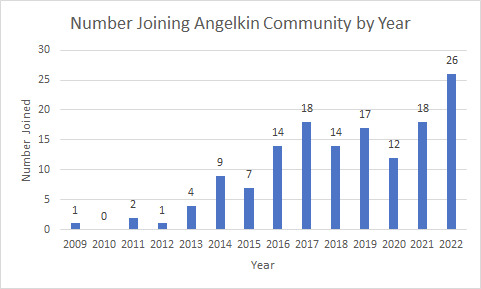
Fig. 2: A bar chart displaying the year still-active members of the Tumblr Angelkin community joined.
An important thing to note is that this question is specifically asking still-active members what year they joined. As such, it’s difficult to tell whether the sharp increase in membership in 2022 and adjacent years is due to an increase in Angelkin awakenings, or simply due to members who joined more recently being more likely to still be active in the community than older members who may have left Tumblr or simply gone inactive within the community.
An interesting note is that the increase in recruits began in 2016. A year frequently mentioned, 2016 was both a renaissance and a trial for the Tumblr Angelkin community. Despite how the Angelkin community was torn apart by the events in the years around 2016, there seems to be a decent amount of members from that time still active, though likely also biased by the submissions of the Census-runners.
Regardless, the modern Angelkin community on Tumblr is still dominated by those who’ve joined in more recent years, especially 2022. The high levels of recruitment in 2020-2022 is most definitely influenced by not only recency bias, but also the effects of the COVID-19 pandemic and lockdowns bringing more opportunity for exploration and introspection. Whether the numbers from these years will stay active is the subject of a future Census.
Age
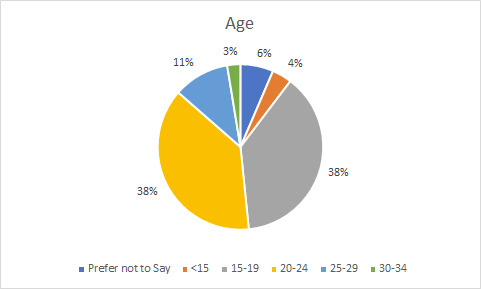
Fig. 3: A pie chart displaying age ranges of active community members.
The current Angelkin community is dominated by members aged 15-24. Any members outside of this ~10 year age range are an extreme minority. It’s difficult to analyze the ages of the responses who declined to share their age range; but they are enough of a minority that being included within this section of the results is insignificant enough to not clutter results. It could be speculated that the members of the non-sharing group are on the older or younger extremes of results, due to the influences of 90s internet safety campaigns on elder members and of good common sense for much younger members, but this is speculation and should not be taken as legitimate data.
It can also be speculated and discussed that the 15-19 age range accounts for many of the recruits in the 2020-2022 recruitment range, while many in the 20-24 age range were likely members in the 2016 era. But again, this is speculation and cannot be taken for a legitimate conclusion.
All in all, the current landscape of the Tumblr Angelkin community is very young, which holds consistent with historical demographics.
Do You Consider Yourself Abrahamic in Origin?

Fig. 4. A pie chart displaying the proportions of responses that are Abrahamic angelkin.
With “Abrahamic” being defined as “any religion that recognizes the religious figure of Abraham as part of their religion, including Christianity, Islam, and Judaism”, this identification is the source of a large split in the Angelkin community, both in and out of Tumblr Angelkin communities. While the concept of an angel originates in Abrahamic religions, there are those within the Angelkin community who do not consider their origins to have ties to any of the Abrahamic religions. This may be because they originated with a deity from a non-Abrahamic religion; it may be because they’re of a fictionkin origin; they may not have religious or spiritual ties at all.
According to the Census data, Abrahamic Angelkin dominate the Angelkin community. (This does not mean that they themselves practice an Abrahamic religion; simply that their Angelkin identity is tied to Abrahamic religion(s).) However, the proportion that definitively doesn’t identify as Abrahamic is more significant than hypothesized when creating the Census, and implies that non-Abrahamic Angelkin are a larger and more quiet part of the community than expected. The amount unsure is also surprising, and if future Censuses are administered, it would be interesting to observe any changes in these proportions as the “unsure” demographic learn more about their origins.
A follow-up question asked “If not Abrahamic, how would you describe yourself?”. The answers of this were sorted into various broader categories. We hesitate to discuss these here, as the results can be somewhat presumptive, and would require definitions of the categories these results are sorted into, so they may instead be the subject of a future post.
Do you consider yourself a fallen angel?

Fig. 5. A pie chart displaying the proportions of responses that identify as fallen or not fallen angels.
With “fallen” meaning “was once in service of God/a deity and has since left/been banished from service”, 44.5% of responding angelkin (69 respondees) do not consider themselves fallen, while 33.5% (52 respondees), and 21.9% (34 respondees) were unsure. Unfortunately, a relevant portion of the unsure respondees seemed to also be unsure as to how to respond to a survey, and when clarified, said that they responded that way because they were not Abrahamic. This skews the data and could make the proportion of the results unreliable. However, we chose to keep the responses in because not being Abrahamic does not necessarily mean that an angel is unable to fall. As such, though it could skew the data, we felt the responses worth including in the results regardless.
The proportion of fallen to non-fallen angelkin was much more even than expected. Non-fallen angelkin dominate, though that may be because they have more tags frequented on the original census post than fallen angelkin, who overlap with demonkin rather than divinekin tags fairly often. If this census was run again in future years, it may be good practice to expand the unholykin tags so as to capture a larger relevant demographic, and/or to specify that fallen angelkin are included more visibly in the post, just in case there was unintentional bias.
If you are part of a multiple or plural system, are any of your other headmates/alters angels?
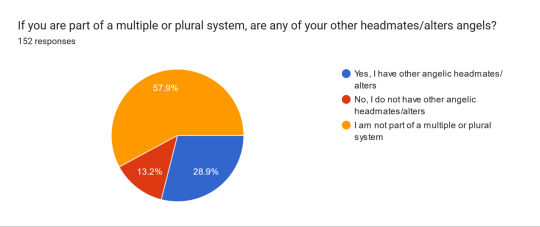
Fig. 6: A pie chart displaying the proportions of respondents who are or are not part of a system, and if so, whether or not they have other angelic headmates or alters.
While 57.9% (88 count) of respondees are not a part of a multiple or plural system, there are a total of 42.1% (64 count) of respondees to the census were indeed a part of a multiple/plural system. From here on, the 64 respondees that are part of a multiple or plural system will be addressed, while the respondees who are not will be ignored.

Fig. 7: A pie chart displaying a subset of data taken from the question about proportions of altars. It only has the data on those who are part of headspaces/systems, and depicts the proportions of those respondents who have or do not have other angelic headmates/alters.
Of the 64 total respondees, 68.8% (44 count) have other angelic headmates/alters besides themselves, while 31.3% (20 count) do not. While we are under no illusions that this data in any way counts as significant, as it’s a very small and biased sample size, the amount of respondees with other angelic headmates/alters is notably double that of those without, which, if it ever ends up being proven as a larger pattern in the angelkin community- depending on the proportion of respondees that identify as spiritual angelkin- could have very interesting theological implications within the angelkin community and could be a relevant topic of discussion. However, until this is fully explored (if it ever is) our team will not be jumping to make any conclusions about larger community patterns or about theology.
Do you consider your angelkin experiences to be primarily psychological or spiritual in origin?

Fig. 8: A pie chart depicting responses to whether the respondent’s experiences are primarily psychological or spiritual. Other categories are included, as responses have nuance.
To the question above, we had a total of 149 responses. As we can see from the results above, of the respondees to the census, a significant majority identify as spiritual angelkin, at over half of the responding community members as of 2022. This is followed by the lagging runner-up, psychological angelkin, at 22.1%. At 16.8% was respondees who identified roughly equally as both, with 4% unsure of their identity origin, and one notable respondee (0.7%) identifying as a literal angelkin. It should be noted that this was from a fill-in response. While most fill-in responses were cleaned into the categories above, this respondee did not fit into any. They also did not provide further explanation of what this meant in the context of the question, so we do not feel comfortable elaborating or further categorizing on this. We will let it stand for itself.
The overwhelming majority of the angelkin community being spiritual does give a decent baseline for what one can expect among interactions with other community members. It is important to remember that this doesn’t mean that it should be considered the standard or default, but simply be used to help set a baseline of expectations for inter-community discussions. When we speak to angelkin community experiences, it may be good to note what origin one is speaking from.
Do you consider your angelic identity to also fall under another another label (like demonkin or faekin)? If so, what labels do you also use for your angelic identity?
To preface, the validity of the data of this question in particular is highly questionable. Going through the responses- which will not be presented here as a result of this question of validity. We suspect that many respondees did not answer whether or not their angelkin identity overlapped with another otherkin identity, but rather answered what other identities they have alongside their angelkin identity. As such, some respondees may have been answering the relevant question, and some may have been answering what they thought was the question. This part of the survey was mostly a matter of curiosity anyhow, so we’re not too upset over not being able to fully present the results. We did find a small amount of interesting data, which will be listed below under the assumption that they are overlaps:
17 respondees’ identities overlapped with demonkin
1 respondent overlapped with devilkin
8 respondees overlapped with deitykin
2 respondees overlapped with eldritchkin
And 1 respondent very interestingly overlapped with crystalkin.
While again, this data has no relevance to the overall survey, we thought it was interesting. Have fun with it.
Discussion
The biggest takeaway from all of this is about the number of respondents. We got a whopping 155 total respondents, though not all of them answered all of the questions. That is much larger than expected! Our team has fond memories of updating each other on the number of respondents, with us being exuberant when we reached 100, and shocked when it went over. The Tumblr angelkin community in 2022 was truly larger and more active than we had been expecting! For a small community that’s faced plenty of what can be called “extinction events”, the current age of the Tumblr angelkin community has an incredible amount of potential.
To reach this potential, however, we must know each other and be willing to speak with each other. In the beginning of our report, we mentioned how distant the angelkin community on Tumblr has become from itself. It’s challenging to find someone through the deluge of aesthetic tags, or through tags that have been hijacked and forcibly turned into aesthetic tags. To survive the current age, we must find each other and revive our community through connections. We must not only be able to find each other, but to know each other and be willing to speak with each other, even if only in a casual way. The members of our team have no expectation of theological discussion or even philosophical agreement between members of the angelkin community, especially due to the overall young demographic of the community as of 2022. But we would like to provide an avenue of finding one another to open that door.
It should also be noted that none of the data presented here should be considered significant or reliable. We have found difficulty with respondees correctly interpreting questions, which throws plenty of the data here into question, but there’s also a matter of the sample size. Our census has reached many more than expected, yes, but it’s currently the only data we have on the size of the angelkin community, and as such we have no idea if it actually represents an accurate community size. Without knowing if we were able to reach a large and varied enough portion of the community, with this census being by nature a self-reporting questionnaire, we would not take any of the data obtained or showcased to be representative of the community even back in 2022, before the inevitable demographic shifts that would have come in the 21 months that have passed since this survey was released, and the 9 months since it closed. The inadequate speed of the release of data by our team is to blame in part, demographic shift in a rapidly changing online environment is inevitable.
In order to better understand and reach our community, we must reach out to each other, we must find each other, and we must know each other. If there is any takeaway from the 2022 Angelkin Census, it should be that. That we must rebuild our community and walk through 2023 and into 2024 together.
We thank you for your responses, and of course, for your time.
-The @angelkincensus team
9 notes
·
View notes
Text
YUMAI WEEK RULES AND GUIDELINES
Any creative art forms are allowed.
No NSFW unless the characters have clearly been aged up.
Include any TW / CW if needed.
Please include IDs (Image descriptions) or ALT text for any art. If one isn’t included, I will include one.
I will not include any works that use racist tropes about the Inuit/Inupiaq community. This does not include works that discuss racism within the ATLA universe toward the Water Tribe.
Absolutely NO AI art will be accepted.
HOW TO SUBMIT:
Use the tags "yumai week 2023" or "yumaiweek2023" and @yumai-week!
If you wish to submit to the ao3 collection, I have explained the instructions there on how to do so ♡!
If you have any questions about anything, I'm here to answer them!
3 notes
·
View notes
Note
When I tap the rules/guidelines link, it just takes me back to the original post? Is it cause I'm on mobile? 😔
That's strange, it might be a mobile glitch, yeah. Not sure how to fix it so here's the text from the page:
RULES/GUIDELINES
(Links on the original page have a citation and the text from those pages is under the read more in case the links here also don't work).
As with years before, contributions can be emailed directly to gakucollab(@)protonmail.com (no parenthesis) at any time within the submissions window. It isn’t a requirement, but if you’d like to let us know you’ll be participating, you can also sign up here. [1] There isn’t an application process, so feel free to start on your piece right away!
Rules:
Only submit works made by you for this event, and don’t post them until the full collab is posted
Works containing explicit content, pairing allusions, or components not made by you (like mmd models) will not be accepted
Images should be 800 pixels tall minimum, and will be posted to our blog as is, as well as cropped to 2:3 (if they aren’t already that ratio) for a collage
When submitting, please include:
Your name/nickname/username (the name or names you want to be credited as on the collab)
Your social media
A description of your image
(We also request you use the description you submit as alt text or an image description [2] when posting your piece).
More detail [3] | Questions answered [4] | Templates [5]
If you have any questions, please contacts us here or by mail at gakucollab(@)protonmail.com.
****
The URL is https://gakucollab.tumblr.com/collabrules if you want to try copying and pasting. Let us know if anything still doesn't work.
****
1. Sign up
https://forms.gle/9Lx3uLS6rFZpmqSe8 || External link
2. On alt text and image descriptions
https://gakucollab.tumblr.com/imagedescriptions
Text from the page:
IMAGE DESCRIPTIONS AND ALT TEXT
Alt text and image descriptions make the collab more accessible to those who use screen readers.
Alt Text
A brief description of an image located within its code. Tumblr, Twitter, and Instagram all have ways of adding alt text to images when posting them. Instructions for desktop are written below.
Tumblr
Create a new post. If the beta post editor is off, turn it on in the top right corner.
Upload your image as you normally would.
Click the circle with three dots in the bottom right corner of the image, and click “update image description.”
When you’re done, click “update.”
Twitter
Upload your image.
Click “edit” in the bottom right corner of the image and then “alt” above the image, or “add description” below the image.
When you’re done, click “save” in the top right corner.
Instagram
Upload your image.
When you reach the caption page, open “accessibility” below the caption section.
It will autosave as you type.
Image Descriptions
A description of an image in the body of the post it’s on. May be longer than alt text. Image descriptions can be written directly in the description, caption, or body of any post. They should not be put under a “read more.”
Example of image description formatting:
[ID: A digital drawing of Gackpo smiling with his eyes closed and holding his fan over the lower half of his face. End ID.]
3. More detail
https://gakucollab.tumblr.com/detailedrules
Text from the page:
Bold text is not covered in the rules above.
General:
There is no limit to how many pieces you can submit
All content:
Can be based on existing works or fully original
We’re currently not accepting edits, merchandise photos, mmd pictures, or song covers, unless you are the creator of the components or have permission to use them
Art and writing are both accepted. Ask us about other art forms!
Pictures:
Digital and traditional art are both accepted
Images will be featured on the collab’s blog, as well as in a collage. Some images may be cropped for the collage to fit a 2:3 aspect ratio, whereas on the blog, they’ll remain as they were submitted, uncropped. Whether your piece is 2:3, another ratio, or you submit two versions is up to you, but please keep this in mind when using text in your image
Please include a description of any image you submit, and use it as alt text or an image description when publishing your work. If a description isn’t provided, one will be written for you, but it’s preferred that you write it for the most accuracy. If one is provided to us but isn’t in your post, we’ll add it when it’s reblogged/retweeted
Text:
Prose and poems are both accepted
Prose works must be self-contained
Suggested length for prose: 500 and 5000 words
Suggested length for poems: 100 to 2000 words
Do not use the complete lyrics of a song as the main backbone of your work unless you are the song’s producer or have permission to use it
4. Questions answered
https://gakucollab.tumblr.com/tagged/questions%2022
This one's just a tag, so searching "questions 22" on the blog should give you the same result.
5. Templates
https://drive.google.com/drive/u/1/folders/1wl2w4noNm0rSrrSfwLTx6FnmYGq4X4Gs || External link
2 notes
·
View notes
Text
What role does user experience (UX) play in office interior design websites?
1. Intuitive Navigation:
A well-designed office interior design website begins with intuitive navigation. Visitors should be able to find what they're looking for effortlessly. Clear menus, logical site structure, and prominent calls to action (CTA) buttons guide users through your content and services.
2. Responsive Design:
In an age where users access websites from various devices, a responsive design is non-negotiable. Your office interior design website must adapt to different screen sizes, ensuring a seamless and visually appealing experience on desktops, smartphones, and tablets.
3. Visual Impact:
Visual appeal is paramount in interior design, and your website should reflect this. High-quality images, compelling visuals, and a harmonious color scheme create a visually engaging experience that resonates with your audience.
4. Speed and Performance:
No one likes waiting for a website to load. Optimize your website's speed and performance to prevent users from bouncing due to slow page load times. Faster load times enhance UX and can positively impact search engine rankings.
5. Consistent Branding:
Consistency in branding is key to creating a memorable experience. Your website should reflect the same branding elements and design style as your offline marketing materials, creating a cohesive brand identity.
6. Informative Content:
Educational content is a valuable component of UX. Informative blog posts, case studies, and project descriptions not only engage your audience but also establish your expertise and design philosophy.
7. Contact Information:
A website that encourages user interaction is essential for UX. Place your contact information, including email, phone number, and contact form, prominently on the website so visitors can easily get in touch.
8. User-Friendly Forms:
Optimize any forms on your website for user-friendliness. Ensure that they are easy to fill out, provide clear instructions, and offer immediate feedback upon submission.
9. Interactive Elements:
Engage users with interactive features such as image sliders, hover effects, and interactive menus. These elements make the website experience more dynamic and memorable.
10. Testimonials and Social Proof:
Incorporate client testimonials and reviews to build trust and credibility. Social proof reassures users that your services are reputable and trustworthy, enhancing their overall experience.
11. Personalization:
A tailored user experience can set your website apart. Implement personalization features that customize content based on user behavior, preferences, or demographics.
12. Accessibility:
Ensure your website is accessible to all users, including those with disabilities. Features like alt text for images, easy-to-read fonts, and keyboard navigation improve accessibility and cater to a wider audience.
13. Interactive Maps:
For local clients, interactive maps that display your office location can enhance UX by helping users find their way to your physical location with ease.
14. Clear Calls to Action (CTAs):
Prominently placed CTAs guide users to take desired actions, such as requesting a consultation, downloading resources, or exploring your portfolio.
15. Feedback and Surveys:
Collect user feedback to continually improve UX. Implement surveys or feedback forms to gather insights on how to enhance your website's functionality and content.
In conclusion, the role of UX in offices interior design websites is pivotal in creating an engaging, informative, and visually appealing online experience. An office interior design website that prioritizes intuitive navigation, responsive design, visual impact, and consistent branding ensures that visitors have a seamless and memorable journey. By focusing on these UX principles, you can create a digital platform that not only showcases your design expertise but also offers a user-centric experience that resonates with potential clients, reinforces your brand, and positions your services as reliable and trustworthy. One can achieve these by getting in touch with the renowned design and build firm such as Flipspaces, who can help you with the same.
0 notes
Text
ELOIACS PDF ACCESSIBILITY
Welcome to ELOIACS, your partner in digital accessibility. We understand the importance of ensuring that your content is accessible to all individuals, regardless of their abilities or disabilities. With our PDF accessibility services, we aim to make your documents inclusive and compliant with accessibility standards, empowering you to reach a broader audience and foster a more inclusive digital environment.
Our Approach to PDF Accessibility
At ELOIACS, we employ a comprehensive approach to PDF accessibility, ensuring that your documents meet the highest standards of inclusivity. Our team of experts utilises a combination of manual techniques and advanced tools to address various accessibility challenges, including:
Semantic Structure: We meticulously structure your PDFs using appropriate headings, lists, and tables, enabling users to navigate content efficiently with screen readers.
Alternative Text (Alt Text): We provide descriptive alt text for images, charts, and other visual elements, ensuring that individuals with visual impairments can access the information effectively.
Colour Contrast: We optimise colour contrast ratios to improve readability for users with low vision or colour vision deficiencies, enhancing the overall accessibility of your documents.
Accessible Forms: We create accessible form fields with proper labelling and instructions, making it easier for users with disabilities to interact with and submit forms electronically.
Document Metadata: We include essential metadata, such as document titles and language specifications, to enhance searchability and compatibility with assistive technologies.
Interactive Elements: We ensure that interactive elements, such as hyperlinks and multimedia content, are accessible and keyboard-friendly, facilitating seamless navigation for all users.
Contact us today to learn more about our PDF accessibility services and request a consultation with our team of experts. Together, let’s create a more inclusive digital experience for all.
0 notes
Text
Lawn Care SEO: Elevate Your Green Space's Search Ranking

In today's digital world, even sectors as traditional as lawn care must navigate the complexities of online visibility. For entrepreneurs in the lawn care industry, understanding and applying the principles of SEO, specifically "lawn care SEO," can be the difference between a thriving business and one struggling to get noticed. This article aims to demystify SEO for lawn care professionals, providing a step-by-step guide to optimizing your online presence and ensuring potential clients easily find your services.
Understanding Lawn Care SEO: The Basics
At its core, lawn care SEO makes your online content discoverable and appealing to search engines like Google. This process involves integrating the keyword "lawn care SEO" and related terms into your website's text, from service pages to blog posts, in a natural way that provides value to your readers. Doing so makes it easier for potential clients to find you when searching for lawn care services.
The Strategy Behind Lawn Care SEO
Effective lawn care SEO isn't just about keyword stuffing; it's about creating a comprehensive strategy that includes:
Keyword Research: Identify your primary and related LSI keywords, such as "organic lawn care tips" and "seasonal lawn maintenance." These terms help search engines understand the context of your content, improving your site's SEO.
Content Creation: With your keywords identified, create content that addresses your audience's needs and questions. This could include blog posts on Lawn Care-related topics. Ensure your content is engaging and informative and positions your brand as an authority in the lawn care industry.
On-Page Optimization: You must ensure your website is optimized for SEO, with clear, keyword-rich titles, meta descriptions, and headers. Use internal links to guide visitors to related content on your site, improving their experience and SEO performance.
Local SEO: Activate your listing on Google My Business and ensure your business's name, address, and phone number (NAP) are uniform across the web to optimize your business for local searches.
Link Building: Find opportunities to earn links from reputable websites in the lawn care and home improvement sectors. High-quality backlinks are a vote of confidence in your site, boosting your credibility with search engines.

Advanced Lawn Care SEO Tactics
To enhance the visibility and distinction of your lawn care business:
Consider implementing advanced SEO strategies.
Start by incorporating multimedia elements such as instructional videos on lawn care techniques or infographics detailing common lawn diseases.
Ensure that all images and videos have alt-tags featuring your focus keyword for improved search engine optimization.
To accommodate the growing number of searches made on smartphones and tablets, you should also prioritize mobile optimization. Make sure your website is adaptable and straightforward to use on these devices. Integrate social sharing buttons across your content pages to encourage visitors to share your valuable resources with their networks, amplifying your site's visibility and driving more traffic to your business.
Measuring Success in Lawn Care SEO
Delving into analytics is essential to gauge the effectiveness of lawn care SEO endeavors. Google Analytics provides a comprehensive array of tools for monitoring user interactions with your website. Vital metrics to track include organic traffic, reflecting the influx of visitors through unpaid search results, indicating the success of SEO strategies in drawing potential customers. Bounce rate unveils the percentage of visitors departing after viewing a single page, hinting at content adequacy or navigational ease issues.
Additionally, conversion rate, perhaps the most insightful metric, displays the percentage of visitors undertaking desired actions like form submissions or purchases, signifying effective content conversion. Keyword rankings offer insight into the visibility of your business in search results, with climbing ranks indicating successful SEO efforts. Employing these metrics enables continual strategy refinement, ensuring increased online traffic for your lawn care business alongside enhanced engagement and conversion rates.

Concluding Thoughts
The evolving digital landscape underscores the critical importance of SEO for lawn care businesses. By putting the tactics in this guide into practice, you're improving your online visibility and setting yourself up for long-term success in a market that is getting increasingly competitive.
Partnering with Tell Me Your Goal for your SEO efforts is an investment in the future of your lawn care business. With our expertise, your business will not only navigate the complexities of SEO but thrive, ensuring your services reach the intended audience and achieve top search engine rankings. Keep your lawn care business from getting lost in the digital shuffle. Tell Me Your Goal excels at driving businesses like yours to the pinnacle of your industry by revolutionizing your online presence with potent SEO tactics that draw in, captivate, and convert your target market.
Ready to transform your lawn care business with effective SEO strategies? Visit Tell Me Your Goal now for your Lawn Care SEO and start your journey to the top of search engine rankings. Whether you want to enhance your website's SEO, create engaging content, or develop a comprehensive digital marketing strategy, we're here to help. Let's grow your lawn care business together.
#lawn care services#lawn care company#lawn care#lawn care SEO#tell me your goal#SEO for lawn care companies
0 notes
Text
Web accessibility issues refer to barriers that prevent people with disabilities from accessing or using websites effectively. Some common web accessibility issues include: 1. **Lack of alternative text**: Images without alternative text (alt text) make it difficult for visually impaired users who rely on screen readers to understand the content of the image. 2. **Improper heading structure**: Websites should use proper heading tags (H1, H2, H3, etc.) to organize content hierarchically. Improperly structured headings can confuse users who rely on screen readers or keyboard navigation. 3. **Inaccessible forms**: Forms without proper labels or instructions can be challenging for users with visual or cognitive disabilities to understand and complete. 4. **Insufficient contrast**: Low color contrast between text and background can make content difficult to read for users with low vision or color blindness. 5. **Unclear link text**: Descriptive link text helps users understand the purpose of the link without needing to read surrounding text. Unclear or generic link text like "click here" can be confusing, especially for screen reader users. 6. **Non-responsive design**: Websites that are not responsive to different screen sizes or device orientations may be difficult to navigate for users with motor impairments or those using assistive technologies. 7. **Inaccessible multimedia content**: Videos without captions or audio content without transcripts are inaccessible to users who are deaf or hard of hearing. 8. **Keyboard accessibility**: Websites should be navigable and usable using only a keyboard, without requiring a mouse. Failure to provide keyboard accessibility can exclude users with motor impairments. 9. **Auto-playing media**: Content that automatically plays audio or video can be disorienting for some users and may interfere with screen reader users' ability to access other content. 10. **Complex navigation**: Websites with complex or unconventional navigation structures may be challenging for users with cognitive disabilities or those using screen readers. Addressing these accessibility issues is crucial to ensure that websites are inclusive and usable for all users, regardless of their abilities.
0 notes
Text
ADA Accessibility
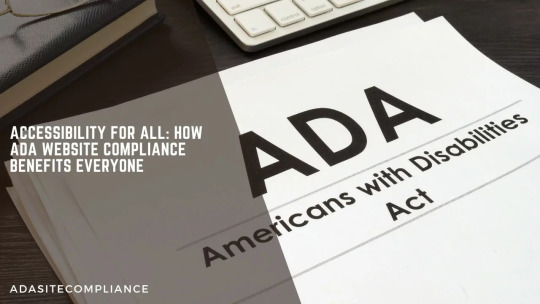
Accessibility For All: How ADA Website Compliance Benefits Everyone
Website design ensures user accessibility, prompting businesses to prioritize ADA compliance. Enacted in 1990, the Americans with Disabilities Act (ADA) marked a significant milestone in fostering inclusivity by addressing disability discrimination across various domains, including digital platforms.
With an estimated 61 million disabled individuals in the United States, ADA compliance assumes paramount importance in the contemporary digital landscape. Failure to achieve ADA accessibility translates to the denial of equal online content access for people with disabilities.
Consequently, businesses must ensure their websites cater to all users, irrespective of disability. However, navigating the intricate web of evolving web accessibility laws poses challenges for companies and organizations.
ADA Site Compliance offers comprehensive solutions, facilitating regulatory compliance. Equipped with a team of adept compliance professionals who track regulatory trends, businesses can ensure their websites meet requisite standards.
What exactly is web accessibility?
Web accessibility encompasses the deliberate planning and development of websites to ensure equitable access and usability for individuals with and without disabilities. By adhering to web accessibility standards, websites enable all users, irrespective of their abilities, to utilize and derive value from web-based services, content, and digital products.
10 Must-Know ADA Accessible Website Benefits
If you are unsure about ADA compliance, take a look at this: Here is a list of ten ways an ADA website benefits everyone:
1. Enhanced Audience Engagement
The integration of WCAG and ADA standards makes websites accessible for individuals with disabilities. By prioritizing adherence to these regulations, businesses engage with an estimated 61 million disabled Americans, thus extending their audience reach significantly.
This proactive initiative provides for broader audience reach, digital marketing, and wider audience engagement for enterprises while underscoring their dedication to fostering diversity and equal access to online resources.
2. Enhanced Search Engine Visibility
While the connection between ADA compliance and Search Engine Optimization (SEO) may not be immediately apparent, it is significant. ADA compliance, such as using alt text, aligns with SEO best practices.
Alt text enhances accessibility and helps search engines effectively understand and index page content. It thus improves the website’s visibility on search engine results pages (SERPs).
3. Optimized User Experience for Users with Screen Readers
An accessible design enhances the user journey, especially those using screen readers, to increase customer satisfaction, thus increasing conversion rates. Effective compliance strategies include:
Clear Information Architecture: Organize content logically to help users of assistive technologies navigate the site effectively.
Navigational Clues: Use breadcrumbs and other navigational aids to guide visitors seamlessly through the website.
Simplified Forms: Use descriptive labels and plain language to simplify form completion and increase conversion rates.
Streamlined Checkout Process: Minimizing the steps required for checkout facilitates faster transactions.
Clear Instructions and Links: Provide concise instructions and descriptive link text at each stage to enhance user understanding and engagement.
Extended Session Timeouts: Ensure that users with assistive technologies have sufficient time to complete tasks without interruptions. These strategies prioritize user satisfaction, engagement, conversion rates, and website performance.
4. Legal Protection
The Americans with Disabilities Act (ADA) mandates online accessibility, emphasizing its significance in ensuring equitable access. With a surge in lawsuits targeting non-compliant websites, adherence to ADA and Web Content Accessibility Guidelines (WCAG) standards offers legal protection, less legal risk, prevents expensive lawsuits, and guarantees user accessibility.
5. Enhanced Brand Image
In today’s socially conscious landscape, diversity and accessibility are not mere buzzwords but integral brand values. ADA-compliant websites signify a brand’s commitment to inclusivity and equal access. This proactive stance enhances brand reputation, fosters consumer goodwill and customer loyalty, and strengthens audience relations.
6. Fosters Creative Exploration
Incorporating more accessible web experiences and design principles demands a commitment to creativity and flexibility in response to evolving trends. Business leaders thus explore innovative solutions and continuously refine website designs to align with accessibility standards.
7. Enhanced Search Engine Optimization (SEO)
Accessible web design plays a vital role in improving SEO and fostering inclusivity. Adhering to WCAG standards by implementing alt-text for images, ensuring straightforward content, and adopting simplified page layouts significantly enhances website SEO.
Furthermore, accessible websites facilitate higher user engagement, reduce bounce rates, and elevate search engine rankings with search engine web crawlers. The website’s online presence and accessibility is further strengthened through additional SEO tactics such as:
Abstaining from using images for textual content
Providing video transcripts
Incorporating descriptive text alternatives for images, links, and buttons
8. Ethical Responsibility
Ensuring web accessibility is both a fundamental human right and an ethical duty. By prioritizing accessibility, you uphold principles of dignity, equality, and inclusivity for elderly individuals and those with disabilities.
9. Employee Retention
Accessible digital platforms empower disabled employees to access essential information, such as important resources like benefits and work schedules, fostering a supportive and inclusive work environment. This increases employee satisfaction and retention as individuals feel valued and accommodated within the organization.
10. Gives a Competitive Advantage
Embracing accessibility not only ensures compliance with regulatory mandates but also drives innovation. By addressing the unique needs of individuals with disabilities, organizations can develop innovative solutions that enhance the overall user experience.
This proactive stance distinguishes them as leaders in promoting inclusion while positioning them ahead of competitors in adopting user-centric design principles.
Web Content Accessibility Guidelines Determine Compliance
Developing an ADA-compliant website necessitates an ongoing process of thoroughly examining elements by web designers. Key considerations to enhance your website traffic usability and accessibility include:
Alternative text for images
Captions for videos
Transcripts for audio content, facilitating accessibility
Optimal color contrast, text size, and keyboard navigation
Assessing Website Accessibility
During the development or reconstruction of a website, it is essential to check accessibility from the outset and continuously throughout the process. Identifying accessibility issues early enables prompt rectification, simplifying the overall correction process.
While adjusting browser settings can reveal basic accessibility aspects, a comprehensive review to ensure compliance with all accessibility standards necessitates a more extensive examination.
While evaluation tools can aid the assessment process, they are not the sole determinant of a website’s accessibility status. Expert evaluation by knowledgeable individuals is indispensable for accurately gauging the accessibility of a website.
Conclusion
The prioritization of digital accessibility underscores proactive engagement with potential customers in the dynamic digital landscape, strategically positioning organizations for prosperity. This concerted effort ensures that all individuals can seamlessly engage with online platforms. Such commitment to accessibility fosters societal benefits by promoting digital equity.
Accessible websites transcend regulatory mandates, embodying the ethos of digital inclusivity. By rendering content, products, and services accessible to the diverse online community, businesses expand their customer base and outreach significantly.
Navigating the intricate web of web accessibility legislation can be challenging for businesses and organizations. ADA Site Compliance offers holistic solutions to ensure alignment with compliance regulations. Get your FREE WEBSITE SCAN today!
youtube
#ADA Website Compliance Benefits#ADA Compliance#ADA Accessibility#Americans with Disabilities Act (ADA)#Web Accessibility#ADA Website Benefits#Web Content Accessibility Guidelines (WCAG)#ADA Compliant Websites#Accessibility Standards#Accessible Websites#Digital Accessibility#Free Website Scan#ada site compliance#web accessibility#accessibility services#diversity and inclusion#ada guidelines#inclusive design#accessible website development#ada compliance solutions#web accessibility audit#digital accessibility#equitable web design#ada regulations#inclusive user experience#ada consulting#accessible content#ada accessibility#web design for disabilities#disability compliance
0 notes
Text
The Importance of Accessibility in Web Development: Designing for All Users
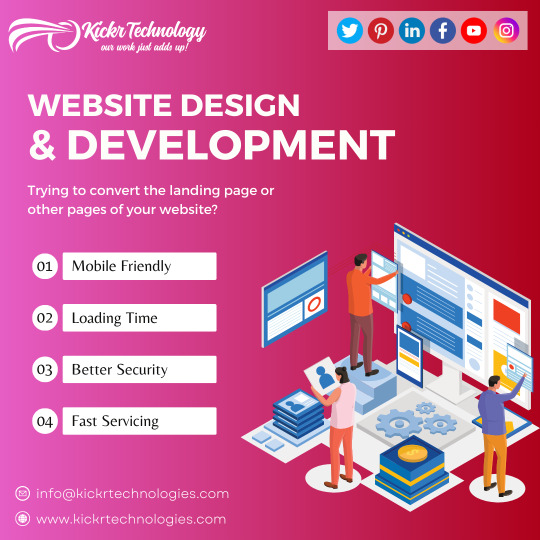
When it comes to establishing an online presence, businesses are rapidly turning to web designing companies to create websites that are not only visually appealing but also accessible to all users. Accessibility in web development ensures that websites are user-friendly and inclusive, delivering to the needs of individuals with disabilities. In this blog, we will explore the importance of accessibility in web development and will know how Kickr Technology, as a top web development company in Noida, is leading the charge in creating optimum digital experiences.
What is Accessibility in Web Development?
Accessibility in web development refers to the practice of designing and developing websites that are accessible to individuals with disabilities. This includes ensuring that websites are compatible with assistive technologies, such as screen readers and braille displays, and that they adhere to the Web Content Accessibility Guidelines (WCAG).
Why is Accessibility Important?
There are several reasons why accessibility is important in web development. To serve every visitor on your site in the correct way, one needs to access the important tactics included in this term. Before discussing the right method let us understand some major reasons behind the need of accessibility term in private policy:
Legal Compliance: Many countries have laws and regulations in place that require websites to be accessible to individuals with disabilities.
Ethical Responsibility: As web developers, it is our ethical responsibility to create inclusive digital experiences that cater to the needs of all users, regardless of their abilities.
Improved User Experience: Accessible websites provide a better user experience for all users, not just those with disabilities.
Some common accessibility issues in web development include
Lack of Alt Text for Images:
Alt text (alternative text) is a vital element for making web content accessible to visually impaired users. It provides a text description of an image that can be read by screen readers, helping individuals who are blind or have low vision understand what the image represents. When alt text is missing, it creates a barrier for these users to fully comprehend the content.
Poor Contrast between Text and Background:
Putting adequate contrast between text and its background is essential to ensure readability for all users, especially those with visual impairments like colour blindness or low vision. When there is insufficient contrast, it becomes challenging for these users to read and understand the text, hindering their web experience.
Inaccessible Forms:
Forms are an important element of many websites, used for various purposes like contact inquiries, registrations, and more. However, when forms are not designed with accessibility in mind, they can pose significant barriers to users with disabilities. Common issues include missing labels, unclear instructions, and lack of proper field validation. These can prevent users from successfully submitting the form and accessing the desired information or services.
Lack of Keyboard Navigation:
Keyboard navigation is an essential aspect of web accessibility, especially for users who are unable to use a mouse due to disabilities like motor impairments. Many websites fail to provide proper keyboard navigation, making it difficult for these users to interact with the website’s content and features. This lack of accessibility can lead to a frustrating user experience and prevent users from accessing the information or services they need.
By addressing these common accessibility issues, web developers can create a more inclusive and user-friendly online experience that caters to the needs of all users, regardless of their abilities.
How Kickr Technology is Helping Businesses Grow?
At Kickr Technology, we understand the importance of accessibility in web development and offer website designing services that prioritise optimum user experience. Our team of skilled professionals works closely with businesses to create websites that are accessible to all users, ensuring that they get access to the latest accessibility standards and guidelines. By doing so, we help businesses reach a wider audience and provide a better user experience for all users, ultimately driving business growth.
Conclusion:
In conclusion, accessibility is an important aspect of web development that should not be overlooked. By creating accessible websites, we can ensure that the digital world is inclusive and open to all users, regardless of their abilities. Kickr Technology, a web designing company in Noida, is at the forefront of this movement, offering website designing services that prioritise accessibility and inclusivity. By choosing Kickr Technology, businesses can be assured that their website will be accessible to all users, helping them reach a wider audience and achieve their business goals.
#Best website design company#kickr technology#Website Design#Website design company#Website design service#Website development#Website development company#Website development service
0 notes
Text
SEO Knowledge: 30 SEO Terms You Should Know
Digital marketing has become an integral part of business strategies in today’s competitive landscape. As businesses strive to establish a robust online presence, understanding SEO (Search Engine Optimization) is paramount. In this article, we’ll delve into 30 essential SEO terms that anyone venturing into the digital marketing realm, especially in Raipur, should be familiar with.
Introduction
In the digital era, SEO knowledge is a key asset for businesses aiming to enhance their online visibility. Understanding the nuances of SEO terms and strategies is vital for a successful digital marketing campaign.
What is SEO?
SEO, or Search Engine Optimization, is the practice of optimizing your online content to improve its visibility on search engine results pages. The goal is to increase organic (non-paid) traffic to your website.
The Importance of SEO in Digital Marketing
Before delving into specific SEO terms, let’s highlight the significance of SEO in the broader context of digital marketing. SEO acts as the backbone of any digital marketing strategy, ensuring that your content is discoverable by the right audience.
Keyword Research
Identifying Relevant Keywords
Keyword research involves identifying the words and phrases your target audience is likely to use when searching for products or services. Utilizing tools for comprehensive keyword analysis helps in selecting the most relevant keywords.
Long-Tail Keywords
Long-tail keywords are specific and niche phrases that target a more specialized audience. Incorporating long-tail keywords in your content can enhance its relevance to specific user queries.
Keyword Density
Maintaining an optimal keyword density in your content ensures that search engines recognize the relevance of your page to specific queries without overstuffing keywords.
On-Page SEO
Meta Tags
Meta tags, including meta title and meta description, provide concise information about your webpage’s content to search engines and users.
Heading Tags (H1, H2, H3)
Properly structuring your content with heading tags not only improves readability but also helps search engines understand the hierarchy and relevance of the information.
URL Structure
Creating SEO-friendly URLs that are concise, descriptive, and contain relevant keywords can positively impact your page’s ranking.
Image Alt Text
Adding descriptive alt text to images enhances accessibility and provides additional context for search engines.
Internal Linking
Strategic internal linking helps search engines navigate your website, establishing relationships between different pages and improving overall site structure.
Off-Page SEO
Backlinks
Quality backlinks from reputable websites boost your site’s authority and credibility in the eyes of search engines.
Social Media Signals
Engagement on social media platforms contributes to your website’s overall authority, indirectly impacting search engine rankings.
Guest Posting
Contributing guest posts to authoritative websites in your industry can generate valuable backlinks and increase your online presence.
Technical SEO
Website Speed Optimization
A fast-loading website enhances user experience and is favored by search engines, positively impacting your SEO efforts.
Mobile Responsiveness
Given the rise in mobile users, ensuring your website is mobile-friendly is crucial for SEO success.
XML Sitemap
Creating and submitting an XML sitemap helps search engines understand the structure of your website, leading to better indexing.
Robots.txt
The robots.txt file instructs search engine crawlers on which pages to crawl or avoid, giving you control over the indexing process.
Local SEO
Google My Business
Claiming and optimizing your Google My Business listing is essential for local businesses to appear in local search results.
Local Citations
Consistent business information across online platforms, known as local citations, improves your local SEO.
Online Reviews
Positive online reviews not only boost your reputation but also contribute to local search ranking factors.
Algorithm Updates
Google Panda
Focused on content quality, the Panda algorithm update penalizes low-quality content and rewards high-quality, user-focused content.
Google Penguin
Targeting link quality, Penguin penalizes websites with unnatural or spammy backlinks.
Google Hummingbird
Hummingbird aims to provide more accurate and relevant search results by understanding the intent behind user queries.
SERP (Search Engine Results Page)
Organic Results
Organic results are the non-paid listings that appear on a search engine results page based on relevance to the user’s query.
Paid Results
Paid results, often appearing at the top or bottom of a SERP, involve advertisers bidding on keywords for ad placement.
Featured Snippets
Featured snippets are concise answers displayed at the top of SERPs, providing quick information without the need to click through.
Crawling and Indexing
Web Crawlers
Search engine crawlers systematically scan websites to collect information, allowing search engines to index and rank web pages.
Indexing Process
After crawling, search engines index the collected data, making it retrievable when users perform relevant searches.
Canonical Tags
Canonical tags help prevent duplicate content issues by specifying the preferred version of a webpage when multiple versions exist.
User Experience (UX) in SEO
Page Loading Speed
A fast-loading website contributes to a positive user experience and is a ranking factor in search engine algorithms.
Mobile-Friendly Design
Responsive and mobile-friendly designs cater to the increasing number of users accessing websites via mobile devices.
User-Friendly Navigation
Intuitive navigation enhances user experience, reducing bounce rates and improving SEO.
Analytics and Reporting
Google Analytics
Utilizing Google Analytics provides valuable insights into website traffic, user behavior, and the effectiveness of your SEO strategies.
Google Search Console
Google Search Console offers tools and reports to monitor your website’s performance in Google’s search results.
Competitor Analysis
Identifying Competitors
Analyzing competitors helps identify strengths, weaknesses, opportunities, and threats, informing your SEO strategy.
SWOT Analysis in SEO
Conducting a SWOT analysis specifically for your SEO efforts helps formulate a strategic plan for sustainable success.
Conclusion
In conclusion, mastering these SEO terms is crucial for anyone involved in digital marketing, especially in Raipur. With a solid understanding of these concepts, you can navigate the dynamic landscape of search engine optimization and implement strategies that elevate your online presence and drive business success.
To know more About our Institute VIDA — Digital Marketing Course in Raipur Please Visit our Website.
Digital Marketing Institute in Raipur | Digital Marketing Academy in Raipur | Best Digital Marketing Course in Raipur | Advanced Digital Marketing Course in Raipur | Best Digital Marketing Institute in Raipur
FAQs
How often should I update my website for SEO?
Regular updates are beneficial, but focus on quality over quantity. Aim for valuable content that meets user needs.
Do I need to hire an SEO expert for my business in Raipur?
While it’s beneficial, learning basic SEO practices can also go a long way for small businesses.
Are long-tail keywords essential for SEO in Raipur?
Yes, especially for local businesses. Long-tail keywords help target specific audiences and improve relevance.
How quickly can I see results from my SEO efforts?
It varies, but patience is key. Significant improvements may take a few months.
What’s the impact of mobile responsiveness on SEO?
Mobile responsiveness is crucial, as Google prioritizes mobile-friendly websites in search results.
Now that you’ve gained valuable insights into SEO terms, go ahead and implement these strategies to enhance your digital presence in Raipur and beyond
#digital marketing course in raipur#digital marketing institute in raipur#digital marketing academy#digital marketing academy in raipur#vida
0 notes
Text
Seo Ideas For Offset Smoker: Enhancing Your Barbecue Game
Barbecue enthusiasts know that using an offset smoker can take your outdoor cooking to the next level. Whether you're a seasoned pitmaster or a backyard grilling aficionado, mastering the art of offset smoking can result in mouthwatering, flavorful meats that will have your guests coming back for more. In this blog, we'll explore some SEO ideas for offset smokers to help you enhance your barbecue game and attract more visitors to your website or blog.

1. Keyword Research
Before diving into creating content for your offset smoker website or blog, it's crucial to conduct keyword research. Identify popular search terms and phrases related to offset smokers, barbecue techniques, recipes, and accessories. Tools like Google Keyword Planner, SEMrush, or Ahrefs can help you discover high-volume keywords with low competition, allowing you to tailor your content to attract more organic traffic.
2. Quality Content Creation
Once you've identified relevant keywords, focus on creating high-quality, informative content that addresses the needs and interests of your target audience. Share tips, tricks, and tutorials on offset smoking techniques, temperature control, wood selection, meat preparation, and recipe ideas. Consider including step-by-step guides, video tutorials, and mouthwatering photos to engage your readers and keep them coming back for more.
3. Optimize Metadata
Optimizing metadata, including titles, meta descriptions, and headings, is essential for improving your website's search engine visibility. Incorporate your target keywords naturally into your titles and meta descriptions to make your content more relevant to search queries. Use descriptive headings and subheadings to break up your content and improve readability, making it easier for both users and search engines to understand the structure of your page.
4. Image Optimization
Images play a crucial role in enhancing the visual appeal of your offset smoker website or blog. However, they can also impact your site's SEO if not optimized properly. Make sure to use descriptive filenames and alt text for your images, incorporating relevant keywords where appropriate. Compress images to reduce load times and improve site performance, which can positively impact your search engine rankings.
5. Internal Linking
Internal linking is an often overlooked SEO strategy that can help improve your website's search engine rankings and user experience. Include relevant internal links within your content to guide users to other valuable resources on your site, such as related articles, product pages, or instructional videos. This not only helps users discover more of your content but also distributes link equity throughout your website, boosting the authority of your pages.
6. User Engagement and Social Sharing
Encourage user engagement and social sharing by enabling comments on your blog posts and sharing buttons for popular social media platforms. Respond to comments and questions from your audience to foster a sense of community and build trust with your readers. Encourage visitors to share your content with their networks, expanding your reach and driving more traffic to your website through social media channels.
youtube
7. Monitor Performance and Adapt
Finally, regularly monitor the performance of your offset smoker website or blog using tools like Google Analytics or Google Search Console. Track key metrics such as organic traffic, keyword rankings, and user engagement to identify areas for improvement and optimize your SEO strategy accordingly. Stay informed about industry trends and algorithm updates to ensure that your content remains relevant and competitive in the ever-evolving landscape of search engine optimization.
By implementing these SEO ideas for offset smokers, you can enhance your barbecue game and attract more visitors to your website or blog. Remember to focus on creating high-quality, informative content that resonates with your audience and incorporates relevant keywords naturally. With dedication and strategic optimization, you can achieve greater visibility and success in the world of offset smoking and outdoor cooking.
0 notes
Text
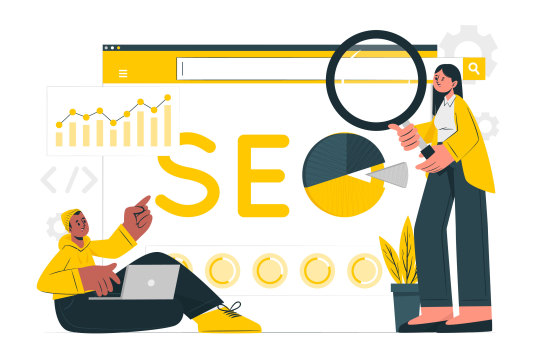
Improving the crawlability of a website is crucial for search engine optimization (SEO) because search engines need to crawl and index your site effectively to rank it in search results. Here are some tips to enhance the crawlability of your website:
Create a Sitemap:
Generate an XML sitemap that includes all important pages of your website. Submit this sitemap to major search engines like Google and Bing using their respective webmaster tools.
Robots.txt File:
Utilize a robots.txt file to instruct search engine crawlers on which pages or sections of your site should not be crawled. Be cautious not to block important content inadvertently.
Clean URL Structure:
Use clean and SEO-friendly URLs that are easy for both users and search engines to understand. Avoid dynamic URLs with long query strings.
Internal Linking:
Implement a logical and well-structured internal linking strategy. Link to important pages within your content using descriptive anchor text. This helps search engines discover and index your pages efficiently.
Navigation:
Ensure that your website's navigation is user-friendly and search engine-friendly. Use HTML or CSS for navigation, and avoid using JavaScript or Flash, as they can be challenging for crawlers to interpret.
Mobile-Friendly Design:
Make sure your website is mobile-friendly, as Google prioritizes mobile-first indexing. Responsive design ensures that your site adapts to different screen sizes and devices.
Page Load Speed:
Optimize your website's load speed. Faster-loading pages are not only user-friendly but also encourage search engine crawlers to index more pages during their visit.
Duplicate Content:
Minimize duplicate content issues. Use canonical tags to indicate the preferred version of a page and avoid having multiple URLs with the same content.
Use Heading Tags Properly:
Employ proper HTML heading tags (H1, H2, etc.) to structure your content. This helps search engines understand the hierarchy and importance of your content.
Image Optimization:
Optimize images by using descriptive filenames and alt text. This not only improves accessibility but also helps search engines understand the content of your images.
SSL Certificate:
Ensure that your website has an SSL certificate, as secure sites are preferred by search engines. This is particularly important for e-commerce websites.
Regularly Update Content:
Regularly update and add fresh content to your website. Search engines are more likely to crawl and index sites that are frequently updated.
By implementing these strategies, you can enhance the crawlability of your website, making it more accessible and visible to search engine crawlers. This, in turn, can positively impact your search engine rankings.
If you want to learn more, click this link:https://www.fiverr.com/s/660Nlb
#videoseo#youtubeseo#channelseo#youtubepromotion#videopromotion#channelpromotion#youtubecreate#channelcreate#SEO#channelsetup#youtubesetup#channeldesign#video#gig#fiverr#fiverrgig#channeloptimization#seofriendly#seoexpert#seofriendlytitle#organic#organictraffic#top5#top10#topsearchranking#trafficmanagement#traffic#ranking
1 note
·
View note